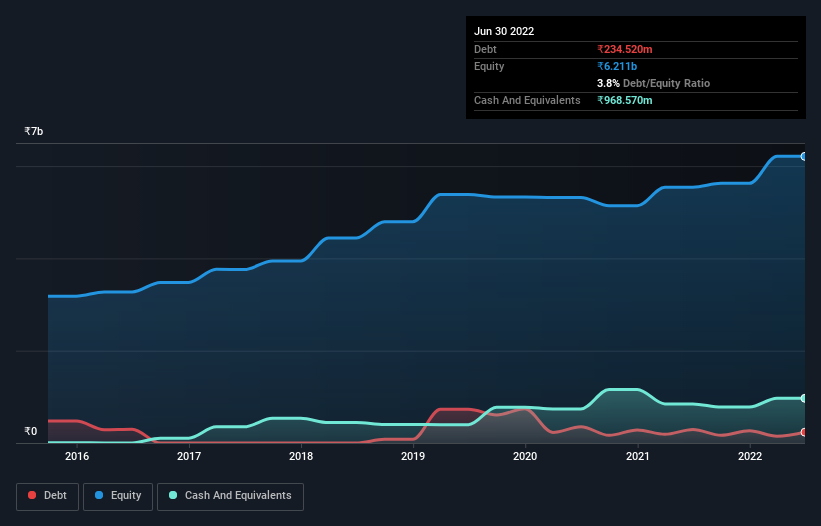- India
- /
- Auto Components
- /
- NSEI:AUTOAXLES
Does Automotive Axles (NSE:AUTOAXLES) Have A Healthy Balance Sheet?
The external fund manager backed by Berkshire Hathaway's Charlie Munger, Li Lu, makes no bones about it when he says 'The biggest investment risk is not the volatility of prices, but whether you will suffer a permanent loss of capital.' It's only natural to consider a company's balance sheet when you examine how risky it is, since debt is often involved when a business collapses. Importantly, Automotive Axles Limited (NSE:AUTOAXLES) does carry debt. But is this debt a concern to shareholders?
Why Does Debt Bring Risk?
Generally speaking, debt only becomes a real problem when a company can't easily pay it off, either by raising capital or with its own cash flow. In the worst case scenario, a company can go bankrupt if it cannot pay its creditors. However, a more common (but still painful) scenario is that it has to raise new equity capital at a low price, thus permanently diluting shareholders. Having said that, the most common situation is where a company manages its debt reasonably well - and to its own advantage. When we think about a company's use of debt, we first look at cash and debt together.
See our latest analysis for Automotive Axles
What Is Automotive Axles's Net Debt?
As you can see below, Automotive Axles had ₹234.5m of debt at March 2022, down from ₹294.9m a year prior. But on the other hand it also has ₹968.6m in cash, leading to a ₹734.1m net cash position.

A Look At Automotive Axles' Liabilities
According to the last reported balance sheet, Automotive Axles had liabilities of ₹3.97b due within 12 months, and liabilities of ₹268.7m due beyond 12 months. Offsetting this, it had ₹968.6m in cash and ₹3.96b in receivables that were due within 12 months. So it actually has ₹684.1m more liquid assets than total liabilities.
This surplus suggests that Automotive Axles has a conservative balance sheet, and could probably eliminate its debt without much difficulty. Simply put, the fact that Automotive Axles has more cash than debt is arguably a good indication that it can manage its debt safely.
Even more impressive was the fact that Automotive Axles grew its EBIT by 122% over twelve months. That boost will make it even easier to pay down debt going forward. When analysing debt levels, the balance sheet is the obvious place to start. But it is Automotive Axles's earnings that will influence how the balance sheet holds up in the future. So when considering debt, it's definitely worth looking at the earnings trend. Click here for an interactive snapshot.
Finally, a company can only pay off debt with cold hard cash, not accounting profits. Automotive Axles may have net cash on the balance sheet, but it is still interesting to look at how well the business converts its earnings before interest and tax (EBIT) to free cash flow, because that will influence both its need for, and its capacity to manage debt. Over the last two years, Automotive Axles reported free cash flow worth 6.9% of its EBIT, which is really quite low. That limp level of cash conversion undermines its ability to manage and pay down debt.
Summing Up
While we empathize with investors who find debt concerning, you should keep in mind that Automotive Axles has net cash of ₹734.1m, as well as more liquid assets than liabilities. And we liked the look of last year's 122% year-on-year EBIT growth. So is Automotive Axles's debt a risk? It doesn't seem so to us. When analysing debt levels, the balance sheet is the obvious place to start. But ultimately, every company can contain risks that exist outside of the balance sheet. For example Automotive Axles has 2 warning signs (and 1 which makes us a bit uncomfortable) we think you should know about.
If you're interested in investing in businesses that can grow profits without the burden of debt, then check out this free list of growing businesses that have net cash on the balance sheet.
New: Manage All Your Stock Portfolios in One Place
We've created the ultimate portfolio companion for stock investors, and it's free.
• Connect an unlimited number of Portfolios and see your total in one currency
• Be alerted to new Warning Signs or Risks via email or mobile
• Track the Fair Value of your stocks
Have feedback on this article? Concerned about the content? Get in touch with us directly. Alternatively, email editorial-team (at) simplywallst.com.
This article by Simply Wall St is general in nature. We provide commentary based on historical data and analyst forecasts only using an unbiased methodology and our articles are not intended to be financial advice. It does not constitute a recommendation to buy or sell any stock, and does not take account of your objectives, or your financial situation. We aim to bring you long-term focused analysis driven by fundamental data. Note that our analysis may not factor in the latest price-sensitive company announcements or qualitative material. Simply Wall St has no position in any stocks mentioned.
About NSEI:AUTOAXLES
Flawless balance sheet established dividend payer.
Market Insights
Community Narratives




